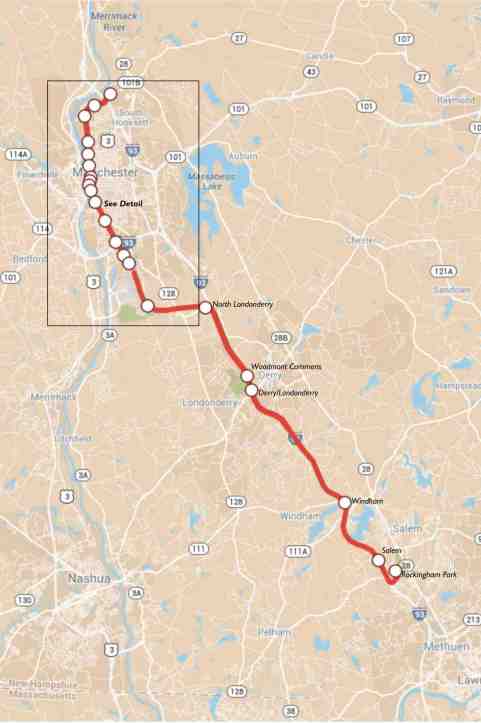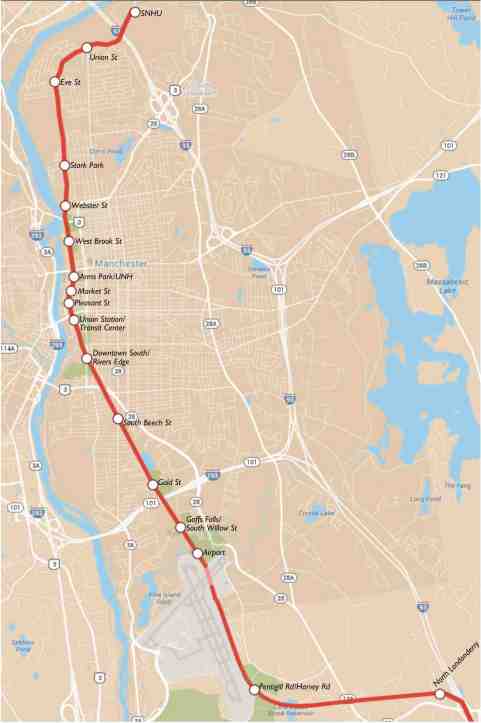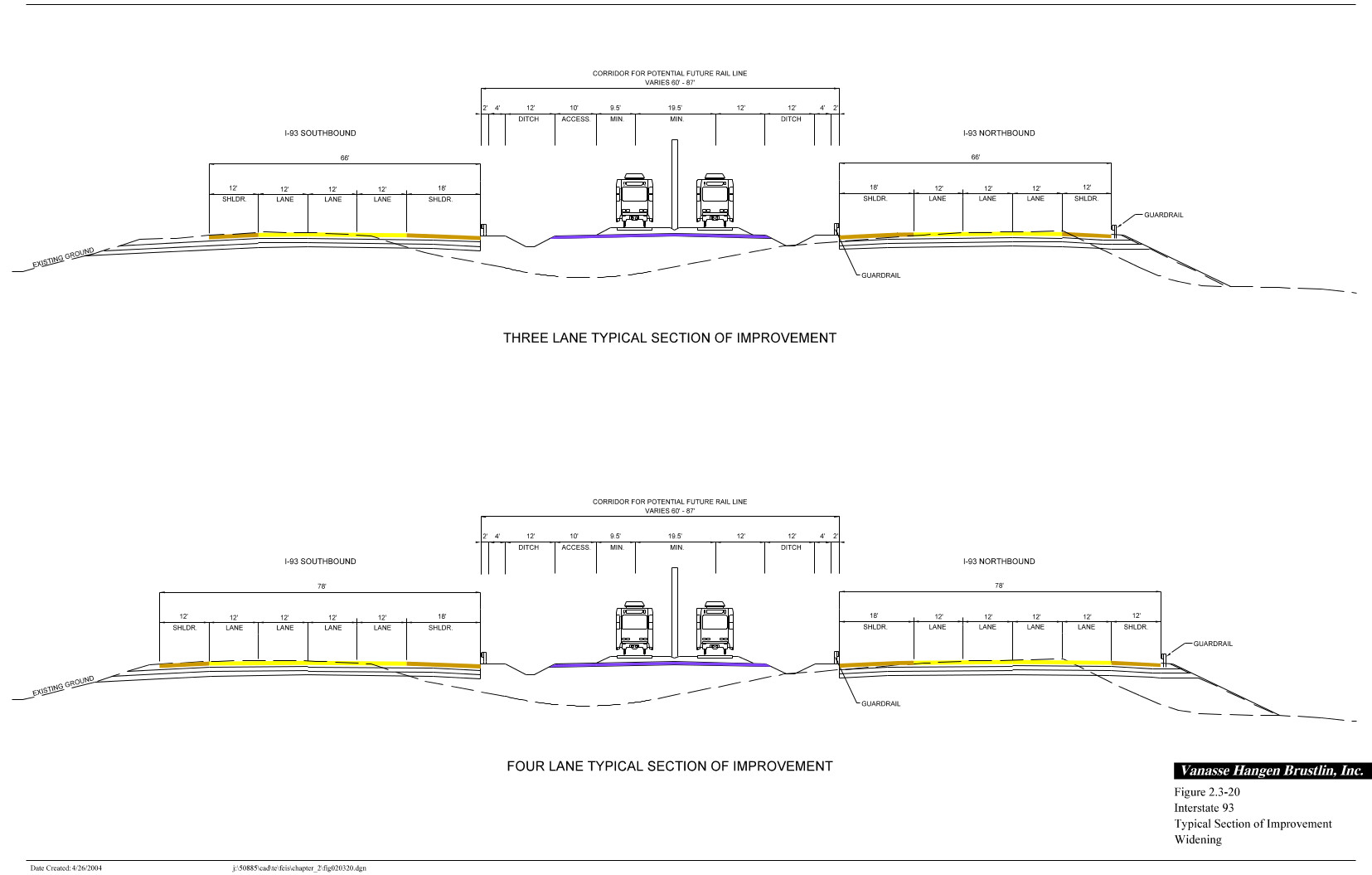FrankLloydMike
Active Member
- Joined
- Jun 24, 2010
- Messages
- 514
- Reaction score
- 0
The thread about a potential Portland-Auburn commuter rail line in Maine got me thinking about the possibilities for a similar line in southern New Hampshire, where there is a greater population density but currently less funding for public transit.
The Capitol Corridor commuter rail line is back on track, though still several years off if it's ultimately approved. That line would connect Manchester, Nashua and Concord with Boston via the existing MBTA commuter rail line that currently ends in Lowell. It has received overwhelming public support and after being delayed by a Tea Party-led legislature during the last legislative session, the new governor, legislature and Executive Council are all proponents of the line. That will almost certainly be a more traditional commuter rail line, though, something similar to what exists in the MBTA commuter rail system now.
Mammoth Metro Rail is a hypothetical 27-mile line that would combine the benefits of urban light rail and commuter rail for Manchester and western Rockingham County. The system is based loosely on the potential rail system northeast of Portland, as well as the Capital MetroRail system in Austin, Texas. That system uses self-propelled diesel-electric vehicles rather than the larger and more expensive locomotive-propelled vehicles found on the MBTA commuter rail. The smaller, self-propelled vehicles allow for the benefits of light rail (quicker and easier boarding, more frequent stops in urban areas, quieter operation) with those of commuter (greater overall distances, and greater distances between stops in outlying areas).


Using this model, the Mammoth Metro Rail would run from SNHU on the far northern edge of Manchester (extending briefly into Hooksett) through downtown Manchester and past Manchester-Boston Regional Airport then running in the median of a widened I-93 to Rockingham Park in Salem. That would connect Manchester's largest city, the state's largest suburbs, one of New England's largest airports, one of southern New Hampshire's largest universities, many of the stat's principal shopping areas, and potentially a future casino at Rockingham Park.
The I-93 widening project that is currently under construction incorporates a right-of-way in the median for future light rail between Manchester and Lawrence, and potentially further south as far as Boston. A letter from 2002 estimated annual ridership on such a line at 450,000 passengers. With rising gas prices and a growing interest in urban living, it wouldn't be surprising if those numbers would be higher today. A line combining the benefits of light rail within Manchester and commuter rail along the I-93 corridor could create development opportunities along its entire length, and potentially lead to a further revival of Manchester and the vital economic engine of the airport, which has been declining as of late.

A line like Mammoth Metro Rail would have to be secondary to the Capitol Corridor, which will connect many more people between Greater Boston and the Merrimack Valley. But a line like Mammoth Metro Rail could be an important investment in the region's future, guiding both land use and economic growth, as well as connecting a relatively densely populated area of New Hampshire (western Rockingham County along I-93) that is currently under-served by transit with the state's economic hub.
For Manchester, it would provide a link between the region's largest university and downtown, creating greater opportunities for downtown student housing and other facilities. Equally important, it would finally link downtown with the airport via a frequent and efficient transit option. It would give those arriving by the Capitol Corridor commuter rail, bus or eventually Amtrak an easy way to get around the city center, and it would provide residents of both the North End and South Side with quick, easy access to jobs, restaurants and shopping downtown without concerns about parking.
With discussion of commuter rail and light rail in Portland, a streetcar in Providence, and the CT Fastrak BRT line under construction in Hartford, it's clear than New England's other midsized cities are getting serious about rapid transit for the metro areas. The Mammoth Metro Rail is just a thought now, but with the political will, it could help secure a vibrant future for Manchester and southern New Hampshire.
The Capitol Corridor commuter rail line is back on track, though still several years off if it's ultimately approved. That line would connect Manchester, Nashua and Concord with Boston via the existing MBTA commuter rail line that currently ends in Lowell. It has received overwhelming public support and after being delayed by a Tea Party-led legislature during the last legislative session, the new governor, legislature and Executive Council are all proponents of the line. That will almost certainly be a more traditional commuter rail line, though, something similar to what exists in the MBTA commuter rail system now.
Mammoth Metro Rail is a hypothetical 27-mile line that would combine the benefits of urban light rail and commuter rail for Manchester and western Rockingham County. The system is based loosely on the potential rail system northeast of Portland, as well as the Capital MetroRail system in Austin, Texas. That system uses self-propelled diesel-electric vehicles rather than the larger and more expensive locomotive-propelled vehicles found on the MBTA commuter rail. The smaller, self-propelled vehicles allow for the benefits of light rail (quicker and easier boarding, more frequent stops in urban areas, quieter operation) with those of commuter (greater overall distances, and greater distances between stops in outlying areas).


Using this model, the Mammoth Metro Rail would run from SNHU on the far northern edge of Manchester (extending briefly into Hooksett) through downtown Manchester and past Manchester-Boston Regional Airport then running in the median of a widened I-93 to Rockingham Park in Salem. That would connect Manchester's largest city, the state's largest suburbs, one of New England's largest airports, one of southern New Hampshire's largest universities, many of the stat's principal shopping areas, and potentially a future casino at Rockingham Park.
The I-93 widening project that is currently under construction incorporates a right-of-way in the median for future light rail between Manchester and Lawrence, and potentially further south as far as Boston. A letter from 2002 estimated annual ridership on such a line at 450,000 passengers. With rising gas prices and a growing interest in urban living, it wouldn't be surprising if those numbers would be higher today. A line combining the benefits of light rail within Manchester and commuter rail along the I-93 corridor could create development opportunities along its entire length, and potentially lead to a further revival of Manchester and the vital economic engine of the airport, which has been declining as of late.

A line like Mammoth Metro Rail would have to be secondary to the Capitol Corridor, which will connect many more people between Greater Boston and the Merrimack Valley. But a line like Mammoth Metro Rail could be an important investment in the region's future, guiding both land use and economic growth, as well as connecting a relatively densely populated area of New Hampshire (western Rockingham County along I-93) that is currently under-served by transit with the state's economic hub.
For Manchester, it would provide a link between the region's largest university and downtown, creating greater opportunities for downtown student housing and other facilities. Equally important, it would finally link downtown with the airport via a frequent and efficient transit option. It would give those arriving by the Capitol Corridor commuter rail, bus or eventually Amtrak an easy way to get around the city center, and it would provide residents of both the North End and South Side with quick, easy access to jobs, restaurants and shopping downtown without concerns about parking.
With discussion of commuter rail and light rail in Portland, a streetcar in Providence, and the CT Fastrak BRT line under construction in Hartford, it's clear than New England's other midsized cities are getting serious about rapid transit for the metro areas. The Mammoth Metro Rail is just a thought now, but with the political will, it could help secure a vibrant future for Manchester and southern New Hampshire.
